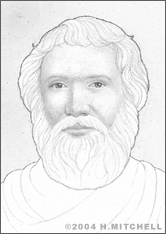Archimedes Archimedes
Mathematician and inventor Archimedes lived more than 2000 years ago, but his life has had a profound and lasting impact on the world. Born in Syracuse, Sicily, in ancient Greece between the years 290 and 280 B.C., Archimedes is said to have studied in Egypt with successors of Euclid and may have been related to Hieron II, the king of Syracuse. The details of his personal life are somewhat of a mystery, but much of his work was documented through correspondence and a series of books and manuscripts.
Regarded as one of the greatest mathematicians of all time, Archimedes is credited with a variety of significant accomplishments ranging from the discovery of pi to the foundations for integral calculus. One of his best-known theorems is the Archimedes Principle, which determines the weight of a body immersed in a liquid. Another is his discovery of the relationship between the surface and volume of a sphere and its circumscribing cylinder.
Archimedes was also a talented inventor, having created such devices as the catapult, the compound pulley, and a system of burning mirrors that was used in battle to focus the sun’s rays on enemies’ ships. In fact, many of Archimedes’ inventions came about as solutions to problems related to the defense of Syracuse in battle. It should be noted that, as Archimedes rarely documented the creation of his practical inventions, little is known about their evolution or whether he did indeed create all that has been credited to him. Researchers don’t dispute his abilities or his genius, however.

He is said to have created the Archimedes Screw. Also known as the Archimedes Snail, this screw-shaped machine was designed for use in irrigation and was built with a helix revolving inside a tube that makes it possible to raise water from a lower to a higher level. It would be powered by horses or by men. It could also be used to move light materials such as sand or ashes. Variations are occasionally employed today, for example, for pumping sewage in wastewater treatment plants.
Archimedes also created a model planetarium, designed a system for expressing large numbers, and made many advances in the understanding of geometry, creating major writings on the sphere and cylinder, spirals, plane equilibriums, conoids and spheroids, and measurement of circles. He also discovered fundamental theorems related to determining the center of gravity in plane figures and solids.
Archimedes died in Syracuse in approximately 212 B.C., as the city was being sacked by the Roman army during the Second Punic War. He was buried there, and on his tombstone is an inscription of pi and a figure of a sphere inscribed inside a cylinder. Scientists continue to collect and attempt to restore manuscripts containing what they believe to be copies of his writings in an effort to learn more about this brilliant man.


